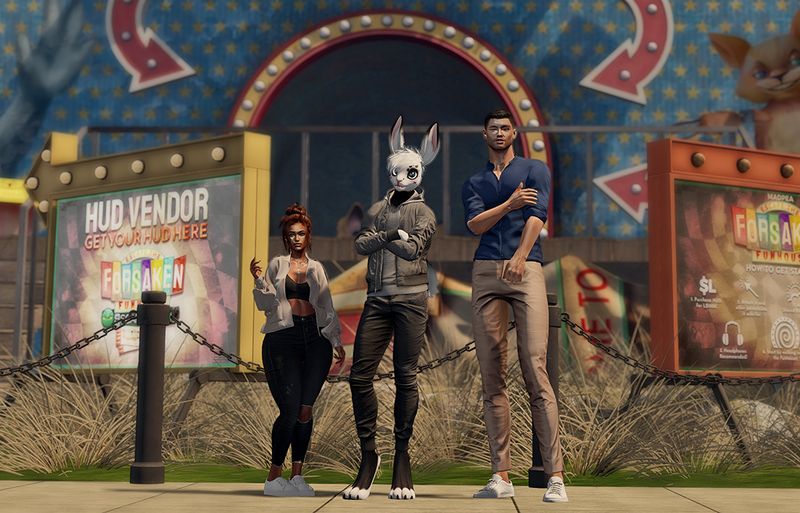Second Life
Second Life, launched in 2003 by Linden Lab, is a pioneering virtual world that allows users to create, explore, and interact within a vast digital landscape. Unlike traditional games, Second Life offers a platform where residents can build environments, socialize, conduct business, and even earn real income. As of 2024, Second Life continues to evolve, integrating new technologies and expanding its community. Check our Second Life Guide for 2025!
What is Second Life?
Second Life is a virtual world where users, known as “residents,” can create avatars to explore various environments, engage in social activities, and participate in a virtual economy. The platform emphasizes user-generated content, allowing residents to build structures, design clothing, and script interactive experiences. This freedom fosters a diverse and dynamic virtual society.
How Does Second Life Work?
Second Life operates through a combination of client software, server infrastructure, and a robust virtual economy. Here’s an overview of its core components:
The Viewer
- Definition: The Viewer is the application that residents install on their computers to access Second Life.
- Functionality: It renders the 3D environment, facilitates communication, and provides tools for building and scripting.
- Access: The official Viewer can be downloaded from the Second Life website. Third-party viewers are also available for specialized needs.
The Grid
- Definition: The Grid refers to Second Life’s server infrastructure that hosts the virtual world.
- Structure: It comprises interconnected regions, each representing a parcel of virtual land.
- Interaction: Residents can teleport between regions, each offering unique experiences and communities.
Virtual Economy
- Currency: The platform uses the Linden Dollar (L$) as its virtual currency.
- Transactions: Residents can buy, sell, and trade virtual goods and services.
- Real-World Exchange: Linden Dollars can be exchanged for real currency, enabling residents to earn income through in-world activities.
How to Join Second Life
Embarking on your Second Life journey is straightforward. Follow these steps to get started:
Step 1: Create an Account
- Visit the Official Website: Navigate to the Second Life Join Page.
- Choose an Avatar: Select a starting avatar; you can customize it later.
- Provide Account Information: Enter a unique username, password, email address, and date of birth.
- Agree to Terms: Review and accept the Terms of Service and Privacy Policy.
Step 2: Download and Install the Viewer
- Download: After creating an account, download the Second Life Viewer compatible with your operating system.
- Install: Run the installer and follow the on-screen instructions to complete the installation.
Step 3: Log In and Explore
- Launch the Viewer: Open the Second Life Viewer application.
- Log In: Enter your username and password to access the virtual world.
- Orientation: New users are directed to Welcome Island, where tutorials help familiarize them with controls and features.
Key Features of Second Life
Second Life offers a rich array of features catering to various interests:
User-Generated Content
- Building Tools: Residents can construct structures, create art, and design environments using in-world tools.
- Scripting: The Linden Scripting Language (LSL) allows for interactive and dynamic object behaviors.
Social Interaction
- Communication: Text chat, voice chat, and group messaging facilitate interaction.
- Events: Regular events, including concerts, classes, and social gatherings, foster community engagement.
Virtual Economy
- Marketplace: Residents can buy and sell virtual goods through the Second Life Marketplace.
- Land Ownership: Users can purchase virtual land to build personal or commercial spaces.
Educational and Professional Uses
- Virtual Classrooms: Educational institutions use Second Life for immersive learning experiences.
- Business Meetings: Companies conduct virtual meetings and conferences within the platform.
Recent Developments and Future Outlook
Mobile App Development
- Private Alpha: A mobile version of Second Life is in private alpha testing, aiming to make the platform accessible on smartphones and tablets. [Source]
- Progress: Ongoing development focuses on feature parity with the desktop version and user experience optimization.
Enhanced Graphics
- PBR Materials: The implementation of Physically Based Rendering (PBR) materials enhances visual realism.
- Mirror Surfaces: Support for reflective surfaces adds depth to the virtual environment.
Scripting and Combat Systems
- Combat 2.0: New scripting functions support advanced combat systems, including damage adjustments and combat logs.
- Scripting Enhancements: Functions like
llComputeHashprovide developers with more robust tools.
Community Engagement
- Destination Guide: Regular updates to the Destination Guide highlight new and popular in-world locations.
- Lab Gab: The “Lab Gab” series offers insights into ongoing developments and community news.
How to Buy and Own Virtual Land in Second Life
Owning virtual property in Second Life allows you to create personalized homes, stores, and entertainment spaces. Here’s a guide on how to buy land and build on it.
Step 1: Understand Types of Land
- Mainland: Shared regions controlled by Linden Lab. You must be a premium member to own Mainland.
- Private Islands: Privately owned regions that offer full customization. They’re popular for businesses, role-play communities, and exclusive events.
- Homesteads and Openspaces: Ideal for users who want smaller, more affordable plots of land.
Step 2: Buy or Rent Land
- Buy from Linden Lab: Become a premium member to access Mainland auctions.
- Buy from Other Users: Buy land directly from other users or rent property from landowners.
- Marketplace Listings: Browse the Second Life Marketplace to find land available for rent or purchase.
Step 3: Build on Your Land
- Build from Scratch: Use the in-world Build tools to create structures, landscapes, and items.
- Buy Pre-Built Objects: Purchase prefab homes, furniture, and landscaping items from the Marketplace.
Step 4: Monetize Your Land
- Host Events: Open event spaces, nightclubs, or business venues to charge admission or sell tickets.
- Rent Out Space: Rent your land to other residents who need a place to stay, work, or build.
- Sell the Land for Profit: Buy low, develop the land, and sell it later for a higher price.
How to Earn Money in Second Life
Second Life offers users multiple ways to make real-world money by leveraging its virtual economy and monetization options. Here are the most popular ways to earn money in Second Life:
Sell Virtual Goods
- What to Sell: Create and sell clothing, accessories, hairstyles, furniture, skins, animations, and more.
- How It Works:
- Use 3D design tools like Blender or Second Life’s in-world creation tools.
- List your items in the Second Life Marketplace where users purchase them with Linden Dollars (L$).
- Earnings: Every time someone buys your product, you receive Linden Dollars (L$), which can be converted to real money through Linden Lab’s exchange service.
Real Estate and Property Rental
- What It Is: Buy, develop, and rent virtual properties.
- How It Works:
- Purchase land plots in Second Life, customize them with buildings or interactive elements, and rent them out to other users.
- Players pay rent in Linden Dollars (L$), which you can convert to real money.
- Profit Potential: By focusing on high-traffic areas, beachfront properties, or event spaces, you can charge higher rents for desirable properties.
Host and Monetize Events
- What It Is: Host concerts, workshops, parties, and events where users pay entry fees.
- How It Works:
- Create a custom event space with decor, lighting, and interactive elements.
- Sell entry tickets using Linden Dollars (L$).
- Types of Events: Fashion shows, exclusive DJ parties, and private workshops are common events that charge admission fees.
Freelancing and In-Game Jobs
- What It Is: Offer services as a freelancer, teacher, model, or virtual assistant.
- Types of Jobs:
- Virtual DJ or Host: Earn tips at nightclubs, lounges, and live events.
- Virtual Teacher or Instructor: Teach skills like 3D modeling, language learning, or scriptwriting in Second Life classes.
- Modeling and Roleplaying: Work as a model for fashion brands and designers launching new items in the metaverse.
- Customer Support Agent: Offer support to businesses or creators running virtual stores.
- Payment: Users are paid in Linden Dollars (L$), which can be cashed out to real-world currency.
Design and Sell Custom Animations
- What It Is: Create custom animations, dances, and gestures for avatars.
- How It Works:
- Use animation software like Blender to design animations.
- Sell your custom animations on the Second Life Marketplace.
- Popular Animations: Dance moves, custom greetings, gestures, and emotes are popular and high in demand.
Play-to-Earn Games (Skill Games)
- What It Is: Participate in virtual casinos, trivia contests, and skill-based mini-games.
- How It Works:
- Compete in puzzle challenges, quizzes, and skill-based tournaments for Linden Dollar rewards.
- Some games have entry fees, but winners earn cash prizes.
- Warning: Be sure to check if these games comply with Second Life’s gambling policies.
Gameplay Video
Pros and Cons of Second Life
Pros of Second Life
1. Rich Social Interaction
- Large and diverse user base with a variety of communities catering to different interests.
- Allows for meaningful social connections, events, and role-playing.
2. Extensive Customization
- Unmatched avatar customization with thousands of user-created skins, outfits, and accessories.
- Allows users to express themselves in unique and creative ways.
3. User-Generated Content Economy
- Second Life has a thriving virtual economy where users can create, buy, and sell content.
- Some users earn real-world income through in-world businesses such as virtual real estate, fashion, and event planning.
4. Creative Freedom
- Users can create and design their own virtual worlds, experiences, and objects with powerful in-world building and scripting tools (e.g., Linden Scripting Language).
- No coding experience is required to create simple objects and environments.
5. Virtual Economy with Real-World Value
- The in-game currency (Linden Dollars) can be exchanged for real-world money, making it possible to earn a living in Second Life.
6. Diverse Range of Experiences
- From social clubs and educational hubs to virtual museums and music events, there is a wide variety of content.
7. Educational and Business Applications
- Used by universities and businesses for virtual meetings, training, and conferences.
8. Long-Standing and Mature Platform
- Over 20 years of development and community-building, with a stable infrastructure.
Cons of Second Life
1. Steep Learning Curve
- New users often find the interface complex and overwhelming, requiring significant time to master.
2. Aging Graphics and Performance Issues
- Compared to modern virtual worlds and VR platforms, Second Life’s graphics and animations may feel outdated.
- High system requirements can result in lag and performance issues on lower-end computers.
3. Limited VR Support
- Unlike newer platforms such as VRChat, Second Life’s VR support is limited and not optimized for a fully immersive experience.
4. Clunky User Interface
- The UI is often considered outdated and not intuitive compared to more modern virtual worlds.
5. Difficult Economic Entry
- While some users make money, starting a successful in-world business requires investment and effort, making it challenging for newcomers.


